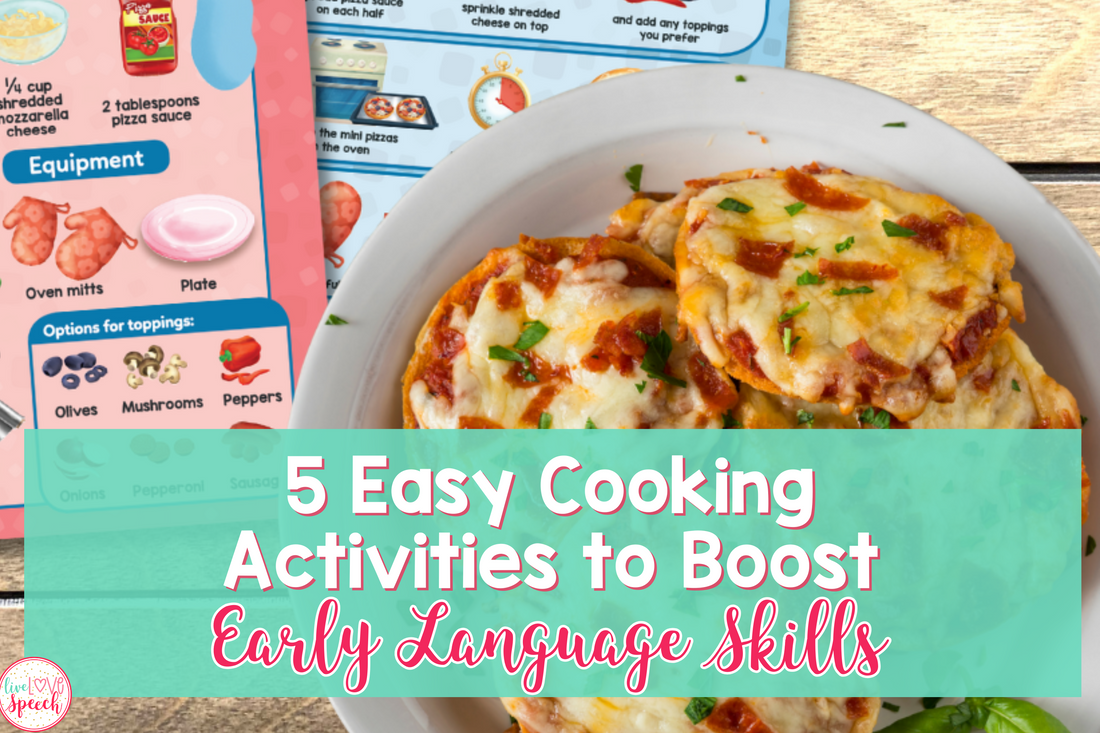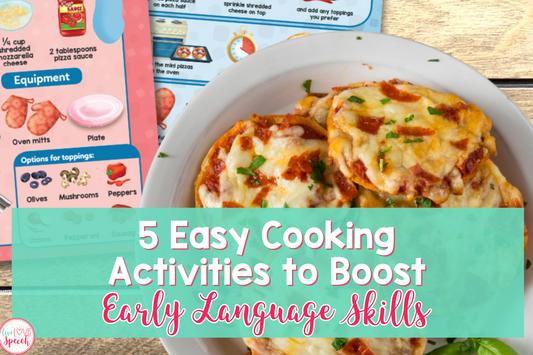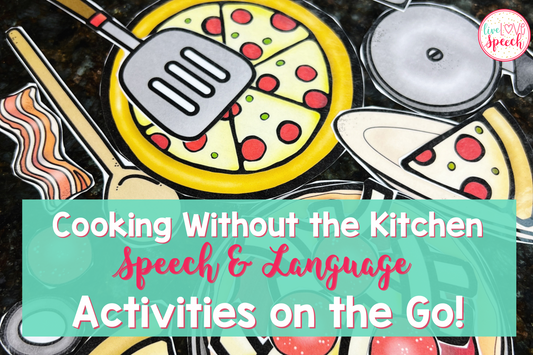
If you’ve been in the kitchen with little ones, you already know it’s rarely neat and tidy. There’s usually flour on the counter, sticky fingers everywhere, and maybe even a strawberry rolling across the floor. But here’s the thing: those messy moments are often where the magic happens.
Cooking with kids isn’t just about preparing a snack. It’s an opportunity to connect, teach, and sneak in powerful language practice without kids even realizing it. As SLPs and educators, we’re always looking for activities that are meaningful and engaging, and cooking hits all the right notes.
Through something as simple as making a fruit salad or whipping up a smoothie, we can target vocabulary, sequencing, turn-taking, descriptive language, and so much more. The best part? Cooking activities for kids are low-prep, budget-friendly, and adaptable across ages and ability levels.
Getting Started with Cooking Activities for Kids
Before we dive into specific recipes, let’s talk about why cooking activities for kids are such a powerful tool for language development.
They are flexible and don’t require fancy ingredients or a full kitchen setup. A few simple supplies, some everyday foods, and a little creativity are often enough. These activities naturally weave in opportunities to name ingredients, ask for help, describe textures, and follow directions.
The best part? Kids are motivated because they get to eat their creations at the end.
A helpful cooking tool? Visual recipes. They provide step-by-step pictures and simple words, which makes cooking accessible for kids who need extra support with sequencing, comprehension, or independence.
Instead of you constantly repeating directions, kids can see the steps, point, and follow along at their own pace. It keeps everyone engaged and cuts down on frustration.
1. Fruit Salad Fun
Skill Focus: Vocabulary & Requesting
A colorful fruit salad is more than a healthy snack. It’s a language lesson in disguise.
-
Lay out fruits like bananas, strawberries, blueberries, and grapes.
-
Invite your child to name each fruit, talk about colors, and decide which ones to add.
-
Model functional phrases such as “I want more grapes” or “Cut the banana, please.”
-
Use simple choices like “Do you want red or green grapes?” to encourage verbal responses.
And guess what? I have a visual recipe that highlights just this activity! The Fruit Salad visual recipe includes pictures for each step like cutting, pouring, and mixing. Kids can follow along by pointing to the step or matching the action. The visuals help them feel confident and successful without you repeating directions a hundred times.
2. Sandwich Building Station
Skill Focus: Sequencing & Following Directions
Sandwich-making is one of my favorite cooking activities for kids for practicing step-by-step directions.
-
Provide bread, spreads, and toppings.
-
Give short, clear directions: “First spread the peanut butter. Then add banana slices.”
-
Encourage your child to retell the sequence: “What did we do first? What comes next?”
One thing I’ve found really helpful here is using simple sequencing cards or even drawing the steps on a whiteboard. Kids can point to “first,” “next,” and “last” while completing each step.
This gives them a visual anchor without overwhelming them and makes it easier to practice retelling the process later. Small additions like asking them to describe each step aloud can also boost expressive language while they make their sandwich.
3. Smoothie Time
Skill Focus: Descriptive Language
Smoothies are a sensory-rich, hands-on, and delicious way to build language skills.
-
Let kids explore by smelling, touching, and tasting ingredients before blending.
-
Ask open-ended questions: “How does the banana feel?” or “What does the yogurt taste like?”
-
Encourage descriptive words like soft, sweet, creamy, cold.
-
Narrate the process step by step: “We’re pouring the milk into the blender.”
And guess what? I have a Strawberry Banana Smoothie visual recipe for this one too! It includes pictures of each step, like pouring milk, adding fruit, pressing the blend button. Kids can match their actions to the visuals, which takes so much pressure off.
Instead of you constantly asking “Okay, what’s next?” they can see it for themselves while practicing descriptive language.
4. DIY Mini Pizzas

Skill Focus: Turn-Taking & Social Skills
Cooking together naturally teaches patience and cooperation. Mini pizzas are especially fun because kids can personalize their own.
-
Set out crusts, sauce, cheese, and toppings.
-
Practice social phrases like “My turn” or “Can I have the cheese?”
-
Use role-play: one child can be the chef taking orders, while another is the customer.
And yes, there’s a Mini Pizza Bagel visual recipe that’s perfect for this activity! It breaks each step down with pictures for spreading sauce, sprinkling cheese, and adding toppings. The best part? Each child can use their own copy, which makes turn-taking so much smoother.
Everyone knows exactly what step they’re on, and it keeps the group work flowing. This is one of my favorite cooking activities for kids because it naturally supports both language and social skills.
5. No-Bake Energy Bites
Skill Focus: Action Words (Verbs)
Rolling energy bites is quick, fun, and perfect for teaching verbs—one of my go-to cooking activities for kids.
-
Use oats, peanut butter (or sunflower butter), honey, and chocolate chips.
-
Highlight action words: pour, mix, scoop, roll.
-
Encourage repetition: “Roll, roll, roll the ball!”
-
Reinforce comprehension by asking your child to act out the verb before doing it.
For this activity, I love leaning into movement and playful repetition. Verbs really stick when kids can act them out repeatedly. You can even turn it into a quick “verb game” by pausing and saying, “Show me how to scoop!” or “Let’s all roll together.”
Adding a rhythm or chant makes it even more fun and memorable. These simple cooking activities for kids become powerful ways to practice both action words and turn-taking, all while making a snack they’re proud of.
Tips for Success for Cooking Activities
Cooking activities are wonderful, but a little planning goes a long way. Here are a few reminders I always keep in mind:
-
Keep directions short and simple.
-
Model language before expecting kids to use it.
-
Use visuals to support understanding.
-
Celebrate all communication attempts, whether verbal or nonverbal.
If you’re new to cooking in therapy, these posts may help:
-
Kitchen Safety for Kids: Teaching Independence While Keeping Them Safe
-
5 Common Mistakes to Avoid When Cooking with Kids in Therapy
Why Cooking Works
So, why do cooking activities for kids work so well for language development? The answer is simple: they are naturally motivating. Kids don’t feel like they’re in a lesson. Instead, they’re engaged in a real, meaningful task that just happens to be full of opportunities for communication.
Cooking also taps into multiple learning styles. Whether a child is watching, listening, touching, or tasting, they’re processing language in a hands-on way. And when kids are invested, they remember.
Make Every Snack a Language Lesson

Cooking activities for kids don’t need to be fancy or time-consuming. Sometimes, the simplest recipes like fruit salad, sandwiches, or smoothies create the biggest opportunities for connection and growth. As SLPs, teachers, and parents, we have the privilege of turning everyday moments into powerful learning experiences.
So next time you’re looking for a way to target early language development, pull out a visual recipe and let the magic happen in the kitchen. And don’t worry about the spills or crumbs. Those are just signs that learning and fun are happening.
SAVE THIS POST
Don't forget to save this post on your favorite Pinterest board so you'll be all set when it comes time to planning your next cooking activity.








